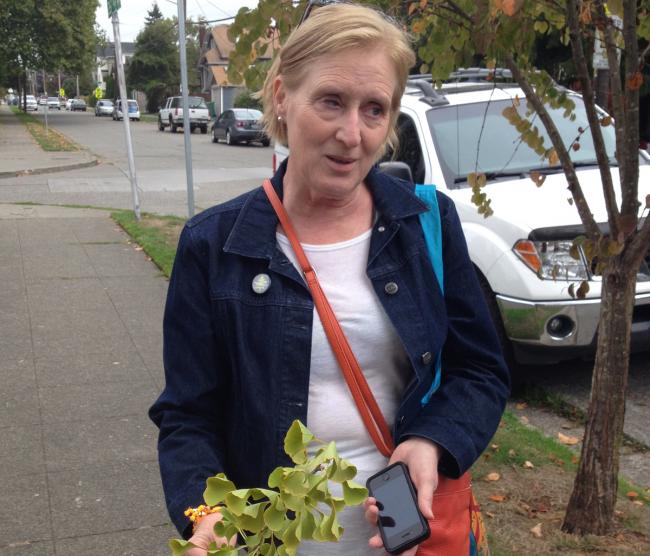At Large In Ballard: The Farewell Tree Walk
Tree Ambassador Diana Gardiner gathers Gingko branches after finding the tree cut down.
Wed, 09/23/2015
By Peggy Sturdivant
Diana Gardiner first contacted me on March 13, 2015. She was a newly trained volunteer Tree Ambassador as part of the City of Seattle’s reLeaf program. She had just led her first Tree Walk in Ballard and wondered if I’d be interested in writing about the training and upcoming walks.
We kept in touch and decided to meet on September 14, 2015 in advance of two September 26, 2015 Tree Walks in Ballard. Unfortunately it’s now the date that marks an event that has changed her as a Seattle citizen.
One week earlier she had seen the Notice of Land Use Action sign on the fence of a corner lot near her home; subdivision to build three-story townhouses. Based on the building plans available on-line she could tell that all the trees in the lot would likely be razed. Gardiner knows trees now, which is why she recognized the Gingko tree as possibly exceptional, meaning it might be left standing per DPD code.
Overnight Gardiner went from the City’s Tree Ambassador to a tree activist who knocked on doors, created a Facebook Page “Keep Ballard Trees Standing” and posted notices all around the neighborhood asking people to connect with her and visit the Gingko and another potentially doomed tree around the corner.
We arranged to meet at Java Bean on Monday at 11 a.m. so that we could walk to the Gingko. I suggested first visiting a Deodar Cedar at 2436 NW 61st that had been declared a hazard needing removal because of development on the adjoining lot. After talking to the frustrated homeowner our informal tree walk continued a half block and turned the corner onto 26th NW. We stopped in shock. Gardiner’s Gingko had already been de-limbed. The lot had been mostly cleared.
Gardiner said later the only comfort was that she was not alone when she saw the tree had been destroyed. We learned from the couple renting the house on unsold section that a crew with chainsaws had tried to enter through their yard the night before, on a Sunday night. They had returned the next morning, just hired to do a job.
This may seem like just another tree story but during this period of rapid growth sometimes the trees coming down is the first indication of what is to come. What follows is rarely based on good design or an integration of trees and structures.
Before we saw the felled Gingko Diana Gardiner said of her role, “How we can value our neighbors if don’t know their names. The trees are our neighbors.” So when we turned the corner her reaction was that of loss. The Gingko was approximately 66 years old and less than 2” too small to qualify as the exceptional tree that might have won it a death sentence appeal. The arborist hired by the new owner of the lot had misidentified the Ginkgo as a Tulip Tree until challenged by Gardiner.
The arborists are supposedly just doing their job too, but since they’re hired by the developers what keeps some of them from being “hired guns”? Accommodating a tree on a lot costs developers on their profit, and they have loans to pay before the profits. The city’s arborist cannot keep up and has to rely on the outside reports. It’s hard to get a second opinion when the tree is already been cut. The drama playing out within two blocks and two trees is happening all over Ballard as there seems to be a disconnect between the City’s departments and it citizens, its tree protection policy and its enforcement.
So where are we now? We are on the street of a man who doesn’t know how to stop the tree in his yard from being cut down. We are with residents who look at the DPD signs lying in construction debris of an already cleared site and wonders why the public comment period is still open. What was the point of public comment?
We are at a place where citizens feel powerless and unheard. We are with the spirit of the late Randi Hansen who kept vigil beneath a nearby tree to keep it from being cut down. We are in the shoes of a longtime Ballard resident who was looking forward to leading Tree Walks on September 26th but will have to swallow her own sense of betrayal over a precipitous end to beautiful tree.
Ballard was built on the deforestation of this land in the 1800s, and so it goes again in 2015. Which means the Tree Walks are both ironic and necessary.
Perhaps buoyed by a possible reprieve for the nearby cedar tree Gardiner is even more determined to introduce people to “the trees that grow right under our noses. The Tree Walks provide structure for citizens appreciating urban trees.” Except now her role is more activist than ambassador, because diplomacy didn’t work.
Information on upcoming Tree Walks (leaving Loyal Heights CC at 10 a.m. & Ballard CC at 4 p.m. on 9.26.15) is at http://www.seattle.gov/trees/
For information Seattle’s trees see TreePac.org and http://saveseattlestrees.org/





